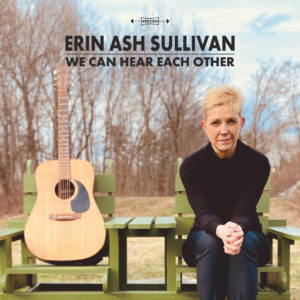 Erin Ash Sullivan’s new disc We Can Hear Each Other Now highlights the singer-songwriter’s ability to weave an exceptionally good song while remaining tastefully self-restrained. Along with producer and multi-instrumentalist Doug Kwartler, Sullivan is like the prettiest song bird on a comfortable spring morning. Away from the music scene for a while, she also makes a remarkable return with an album this strong.
Erin Ash Sullivan’s new disc We Can Hear Each Other Now highlights the singer-songwriter’s ability to weave an exceptionally good song while remaining tastefully self-restrained. Along with producer and multi-instrumentalist Doug Kwartler, Sullivan is like the prettiest song bird on a comfortable spring morning. Away from the music scene for a while, she also makes a remarkable return with an album this strong.
Opening track “Train From Gary” travels a mellow but persistent path. Sullivan’s gentle, tender vocal, acoustic guitar, and Kwartler’s pedal steel move at cruising speed. This platform lets Sullivan’s words have their own space to breathe, taking hold in the listener’s imagination. It’s uncanny how well the two carry the listener along with their quiet but meaningful journey.
“Fabric” weaves acoustic and pedal steel guitar into a perfect, soothing backdrop for Sullivan’s delicate vocal approach. Sullivan rides over this cushion like a painter adding the right touches to a portrait. She gives only enough of her timbre per meter to keep this pretty without obscuring her message of comfort, safety, and reminiscence. Her metaphor matches her instrumental support so well that the entire song can fit the listener like a comfortable material.
“Spring Come Running” moves, appropriately enough, like a running spring. Sullivan’s jaunty acoustic guitar chords and Kwartler’s run of shiny mandolin notes delight the ear with their perky sprint as Sullivan’s voice ambles over. The combination of brief notes within a flow of sound help Sullivan make her point about time and anticipation.
.”Take It From There” finds Sullivan singing a light vocal melody over an easeful accordion. This particular combo, with Sullivan strumming rhythm on her acoustic, makes for a perfectly paced narrative. Sullivan’s songwriting becomes the focal point among the unobtrusive support. Letting her family images roll on like a movie, Sullivan exceeds at working the words, the support, and her slow increase in vocal dynamics into a strong, involving experience for her listener.
Banjo, acoustic guitar, and bari sax create a jaunty 1920s popular music feel in “Fireflies.” Sullivan emits just enough voice per meter to put a sweet top on this playful rhythm. This singer-songwriter carries this nostalgic piece with a charming aplomb. The listener can almost picture her winking while delivering her reveries to this quaint dance of notes in this old-fashioned send up.
“Wind Around You” lets Sullivan showcase her ability to reach a higher, wider expression, turning this into a banner as she makes her way through her ever mounting verses and chorus. This one feels like a pop song in its hooky chorus and inviting vocal climb. While this one might be the one spun most often on local music radio formats, it is not commercialized. It is as earnest and straight forward as the rest of Sullivan’s material on this album. It just has so many things, without trying to, that reach out and grab the listeners’ ear. Beneath her general vocal, Sullivan’s support is made up of solid acoustic guitar strums, bits of mandolin sweetness, and even a bluesy organ.
“Sacred Thread” feels and sounds as Americana as its title suggests. A quiet run of sweet acoustic notes bring out the earthy sensibility in what Sullivan suggests when she sings of barns, cities, and other scenic icons. She coats this all with a sincere vocal, very little technique, which becomes a fine technique for unfurling this particular message.
Sullivan sings in a wider, more dynamic manner in “Ducks In A Row.” That perfectly expresses this song of youthful freedom One feels the songwriter’s need to take a chance on a change in direction. Keeping her vocal melody line nimble with quickened assertions here and there, this one is full of life and vigor. Her chorus is catchy enough to become a live audience sing along while her acoustic guitar and Kwartler’s mandolin, pedal steel, and backing vocal keep an necessary thick, zesty texture just beneath her voice.
“One Man Show” features Kwartler’s fetching electric guitar picking, a perky twang beneath Sullivan’s voice, a strong contrast, each creating the impression of two equal forces, supporting the relationship theme here that it takes two to make it work. This one has a slight commercial appeal, hinting at 1970s singer-songwriters and acoustic rock, just enough to keep it lively. The whole piece is an interesting study in balances.
A sad tale of inevitable doom, “Sheep Shanty” chronicles the loss of harmless animals who were floated on an unsafe, makeshift vessel. Sullivan puts heart into this tune with a persistent strum and an almost Celtic like unraveling of this tale. Her voice seems to punch home the message in each verse, each meter, and it is well fitted to the senseless loss.
Close out track “Radio Show” repeats the album title “We Can Hear Each Other” as its refrain, neatly wrapping up all of the previous themes of expression and of relating to others. Sullivan’s gentle plaint makes her case well in her low key delivery. A tumbleweed of pedal steel and other acoustic instruments carries the message horn.
Erin Ash Sullivan makes an especially reemergence into the singer-songwriter scene with this We Can Hear Each Other album. Producer Doug Kwartler gets a good sound, either at his Hollow Body Studios in Chelmsford, Massachusetts or at Sullivan’s front porch with his Mobile Hollow Body Studio in Harvard, Massachusetts. He wrings every nuance out of her vocals and guitar and his own assortment of instruments. Everything on this album feels and sounds as natural and real as nature.

